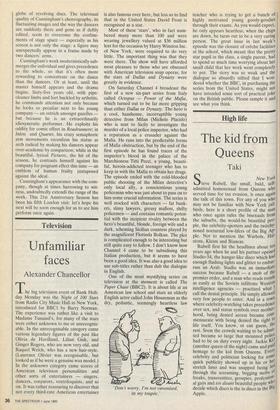Dance
Royal Ballet Tour
Compare and contrast
Julie Kavanagh
The Royal Ballet may have left London last month with their tails between their legs (never has a company been flayed so unanimously by home critics) but on their return, tails were up and even wagging. When I joined them in Barcelona, they were still celebrating the exhilarating re- ception they'd had in Eastern Europe, with half hour 'red runner' ovations. If the Catalan audience was less vociferous it seemed due to excess politeness rather than lack of enthusiasm: applause after a solo or laughter during Elite Syncopations invariably was stifled by a viperish `ssssh'. Of the debuts I saw there, the most notable was of course Antoinette Sibley's in A Month in the Country, which reluctantly I'm under oath not to review until her Covent Garden debut with Baryshnikov next week. Jay.Jolley gave his first Concert Waltz in Elite a nicely ironical unctuous- ness, while Bruce Sansom was straight- laced and very British in his first attempt at the 'Friday Night' solo, a young merchant banker, fresh from Pop. The second cast of Consort Lessons, whom I hadn't seen before, were easily as impressive as the first, adding dimension to David Bintley's fine work by reinterpreting the movements for themselves. Fiona Chadwick was out- standing in the slow movement, displaying the kind of stateliness and autonomy one usually associates with Balanchine's baller- inas. Her technical exuberance also gave lustre to her performance as Aurora in Lisbon — despite the tiny stage and noto- rious one in three rake. With Bryony Brind's seamlessly phrased, superbly con- trolled Lilac Fairy and some lively and accomplished solos compensating for a few casualties of the rake and a bizarre assort- ment of heights and weights in the corps, this was hardly a performance by a com- pany on the rocks, though it was an uneven one.
It's unfair but true that what classical ballet decrees to be the perfect physique is not always endorsed by contemporary dance. Most of the women in Merce Cunningham's company (over from New York as part of the American Festival) combine classical virtues (exquisitely ex- pressive insteps, a supernatural ability to balance, 180-degree turn-out and high ex- tensions) with contemporary qualities of relaxation and novelty in their movements. But I admit to being distracted — especial- ly in Duets, Inlets and Phrases — by some whopping thighs (highlighted by designer Mark Lancaster's vibrant tights worn un- flatteringly under leotards); rigid necks and arms during turns; jumps heaved up by the shoulders and judderingly landed. The men, who are much wilder than the women and less conventionally trained, were parti- cularly lacking in balon. It's hard not to, bring ballet's criteria to a Cunningham performance because although he is one of the greatest dance innovators of the cen- tury, the foundation of his work is classical. What interests him, though, is not the classical ideal of perfection, but rather the ways different bodies can shape and extend the scope of a movement. It's a measure of the comprehensiveness of his work that a sparky little dancer like Karen Fink can shine and make the heftier Catherine Kerr seem almost lumbering in Phrases, where- as in Doubles Kerr acquires a wonderful pliant grace while Fink looks far too balletic.
All the dancers are remarkably good at performing in unison considering each moves to his or her internal rhythm with no guidance from the score, which is com- posed independently from the dance. They also seem able intuitively to synchronise occasional steps with a gurgle or gecko croak coming from John Cage's cockpit- like control panel of sounds. And they are as exact about spacing as timing, moving independently yet in formation, like mig- rating birds. Cunningham's manipulation of stage space and of rhythm is one of the most imitated aspects of his work. One dancer may be bucking frenetically stage left while two ceremoniously promenade diagonally away from him. There will then be a flux of entrances and exits continually changing the pattern of figures on stage; delineating them against the moviescreen- like backdrop and overlapping them against each other like Rauschenberg's globe of revolving discs. The televisual quality of Cunningham's choreography, its fluctuating images and the way the dancers are suddenly there and gone as if deftly edited, seem to overcome the confine- ments of stage space — especially as his screen is not only the stage: a figure may unexpectedly appear in a frame made by two dancers' arms.
Cunningham's work modernistically sub- merges the individual and gives precedence to the whole, so that it's often more rewarding to concentrate on the dance than the dancers. Or at least, until the master himself appears and the drama begins. Sixty-five years old, with pipe- cleaner limbs and feet buckled by arthritis, he commands attention not only because he looks so peculiar next to his young company — an ostrich amongst gazelles but because he is an extraordinarily idiosyncratic performer. He exploits his oddity for comic effect in Roadrunners; in Inlets and Quartet, his crazy semaphoric arm movements reconfirm his status as arch radical by making his dancers appear over-academic by comparison; while in the beautiful, lyrical Pictures, the hit of the season, he contrasts himself against his company for poignant effect this time — an emblem of human frailty juxtaposed against the ideal.
Cunningham's appearance with the com- pany, though at times harrowing to wit- ness, undoubtedly extendi the range of the work. This 21st Anniversary Season has been his fifth London visit: let's hope his next will be soon enough for us to see him perform once again.



















































 Previous page
Previous page